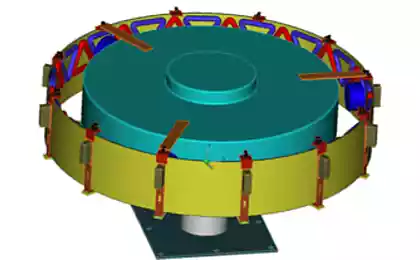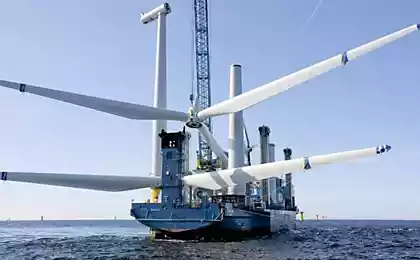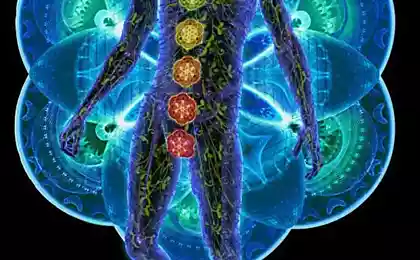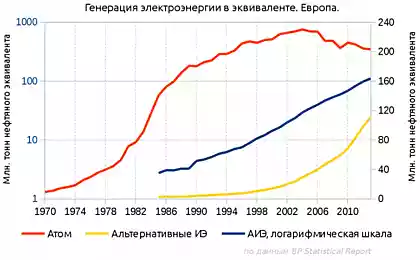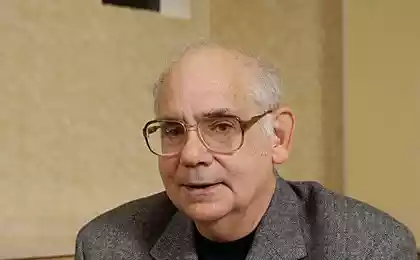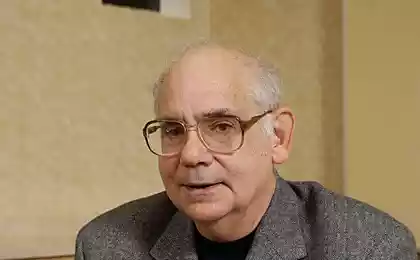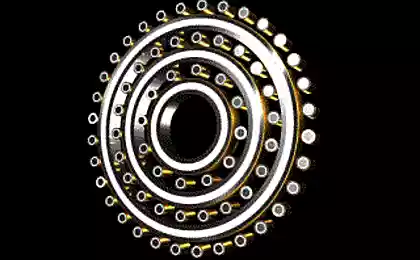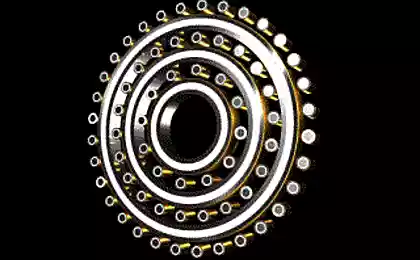694
Mineralnye super technologies and promising energy
Energy super technologies that use physical effects cinetronic nature allowed us to create a range of environmentally friendly Autonomous fuel-free power generators (EG), which efficiently convert the energy of the world cinetronic environment in the energy consumer format. Over the past 125 years we developed dozens of various designs such Aigues, some of them produced in small series. The improvement of fuel-free AG and supertechnology their production cost of EG decreases rapidly, and in a few years may be below $ 200 per 1 kW.
The concept of "cinetronic supertechnology" is a system combining the two approaches author: "cinetronic" and "supertechnology". In cinetronic proved rigorously that all the space the Universe is filled with minimal size and weight (and therefore indivisible, that is truly elementary, basic) particles of matter — "kinetonema (cinemas" — movement, "the throne" is the basic particle, base).
The scale of the Universe, the totality of moving CinemaNow forms a "world kinetron environment" (ISS), which in first approximation can be considered as a dense "Brownian cinetronic gas." ISS has tremendous energy density — more than 1033 j/m3 (estimates obtained through the application of classic models of etherodynamics), almost instantly renewable average energy density due to a huge speed (more 1021м/s — measured in 1987-1990), both CinemaNow and cinetronic waves in the ISS. This allows you to create effective Mineralnye Autonomous fuel-free power generators (EG) — thermal, electric, etc., while the only "fuel" for such are EG Mineralnye streams (waves) of the ISS.
In addition, under certain conditions, ISS may transfer kinematic momentum physical bodies (that is, to create a controlled thrust vector) that allows you to create effective Mineralnye drives, and fuel-free energy (and transport) system based on them that can function in any place of the world.
Basic principles cinetronic in good agreement with known (including classical) physical concepts ("atomistic" model of the world of Democritus, theory of the world Newton's laws of electromagnetism, etc.), and modern physical models (dark matter and Higgs bosons, string theory, etc.).
"Supertechnologies" approach provides an effective structurearticle methods for rapid development and implementation of a wide range of massively popular, environmentally safe, cheap and high quality goods and services (including in the fields of: Autonomous fuel-free clean energy and transport, processing and transfer of information, technological equipment for various purposes, construction, agriculture, Biomedicine, science, education, etc.), which are based on the extensive use of processes and effects cinetronic physical nature and possessing essentially new consumer properties.
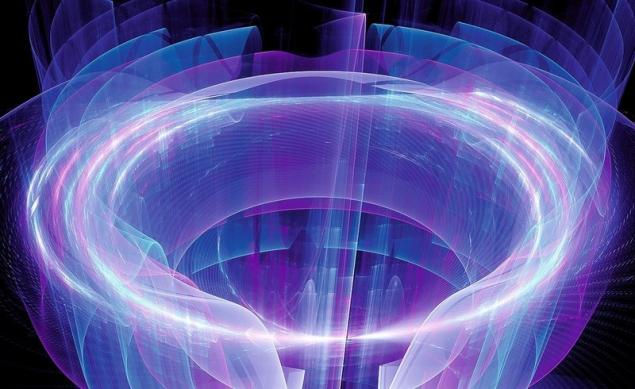
In practical terms, the first fuel-free (in fact — kinetron) power generators (EG) was developed by Michael Faraday in 1831 (unfortunately, this KST-EGO was not entirely fuel-free); John Keely in 1872 (KST-EG using resonant vibration Mineralnye effects); Nathan Player in 1880 (KST-Aigues, using the effect of magnetic induction cinetronic); by Nikola Tesla in 1889 (KST-EG using a high-frequency high-voltage AcrobatReader and the resonant transformer of special design).
Nikola Tesla belongs to these truly prophetic words: "Our world is immersed in a huge ocean of energy, we are flying in an endless space with inconceivable speed. All around floats — all energy. Before us is a daunting task — to find ways to extract this energy. Then, removing her from an inexhaustible source, humanity will move forward with giant steps".
This is followed by the development of Alfred Hubbard (1921), Thomas Henry Moray (1926), Victor Schauberger (1920-1945), Hans Kohler (1920-1950), Wilhelm Reich (1940) and dozens of other inventors in the first half of the last century. Unfortunately, such designs are often not distinguished by high performance and had low stability. There were other disadvantages to such structures, not allowing it to quickly establish its serial production and marketing.
In just the past 125 years, the world has developed several dozens of different designs fuelless KST-EG (and KST-engines), some of them produced in small batches under specific orders. The unit cost of these CST-systems remains high — more than $ 1,000 per 1 kW, however, with the improvement of KST designs of such systems, supertechnology their manufacture and because of the increase in the serial production, the unit cost is falling rapidly and within a few years could decline below $ 200 per 1 kW.
The conversion of energy ISS
The main task of any fuelless KST-EG (that is, the Converter of energy ISS energy consumer format) is the conversion of three-dimensional (3D) format centralnogo Brownian gas of the ISS in the local working volume in one-dimensional (1D) cinetronic stream, which in the second stage is converted into a unidirectional material flow consumer format: W-the flow of the heated coolant, electric-current, high-speed flow of liquid, gas or solid, etc.
It should be noted that the potential power density of the world cinetronic environment may be more than 1052 W/m3, while the power density and energy density of the magnetic, electric, electromagnetic and gravitational fields is disproportionately less power density and energy density cinetronic world environment. Real-KST-EG use only a tiny part of the potential specific power of the ISS — at least 10-40, while the specific power output of this EG may be more than 10 MW/m3 (or 10 kW/l), which is sufficient for practical purposes.

Consider two clear examples of conversion of energy ISS:
Example 1. It is known that a permanent magnet can perform work (mechanical, generate electricity, etc.) for thousands of years without losing its magnetic properties; however, it is obvious that the magnet, doing this kind of work, expends its energy. At the same time, if making the work of the magnet to surround the magnetic screen, then very quickly the magnet will lose its magnetic properties and ceases to perform work. This suggests that the magnet receives reimbursement of its cost of energy from the ISS along the magnetic field lines, which are in fact very thin mineralnymi closed vortices and function as effective "centronova" collecting kinetron energy from the large volume and concentrating it within the body of the magnet.
Example 2. Modern refrigerator, consuming from the power supply 1 kW of power moves from the internal volume to the outside heat power of about 5 kW, that is five times more than it consumes from the mains. If the output thermal power to convert into electricity, it is possible to implement "samosejka" of the refrigerator, turning it thereby into an Autonomous fuel-free KST-EG. Obviously, this is only possible due to the fact that the evaporation and condensation of refrigerant-refrigerator receives energy supply from the ISS: of 5 kW of output heat output 4 kW is the contribution cinetronic energy ISS.
Energy efficiency KST-EG is estimated following two basic parameters:
1. Coefficient of performance (COP) — the ratio of power output to the load (useful output) to total power of all energy flows within the active workspace EG (total power consumption). Efficiency is always less than 1 or 100% as part of consumption (from all energy sources) of power is lost in the EGO in the process of converting it into useful power.
2. Conversion rate power (PFC) — the ratio of power output to the load (useful power) to the power expended to run the EG in the operating mode and its support. Registers in effective KST-EG always significantly greater than 1 (or 100 %) as a smaller part of the power consumption of the ISS is used to start and support the working mode and substantially most of this absorbed power is converted to consumer format, and is transmitted payload. It is therefore often KST-EG is conventionally called "super" or "fuel-less".
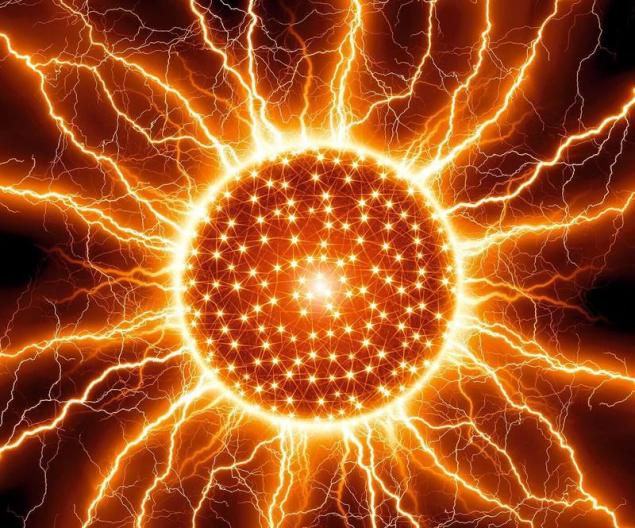
The underlying physical effects used in KST-EG
It should be noted that to date, there are dozens of different physical effects cinetronic nature, used to work KST-EG, and the number of such effects is growing every year. We restrict ourselves to only basic cinetronic physical effects, which are most often used in KST-EG.
All the basic Mineralnye physical effects almost solve similar problems in superanalytic: ensure transformation of the energy cinetronic SD streams Brownian (chaotic) of the ISS in the ID and energy (organized) streams in consumer format: heat flow, electric current, mechanical motion.
Over the past 125 years, the world has developed several dozens of different designs fuelless KST-Aigues, some of them produced in small batches. The unit cost of these CST-systems while more than $ 1,000 per 1 kW, however, with the improvement of designs and manufacturing techniques and because of the increase in the serial production, the unit cost in a few years could decline below $ 200 per 1 kW
1. Kinetron-mechanical "gravity effect". Usually under gravity understand "the attraction of one physical body (object) to others." However, from the first Newton's law, it follows that no two physical bodies at a distance greater than the dimensions of these bodies can impact directly on each other, that is, to pass each other, the kinematic momentum, energy, and information, as in the absence of contact interaction between two bodies each of the bodies moves uniformly (unless the body contact will not interact with other physical bodies). Whence it follows that for indirect physical effects at a distance of one body on another, must be other bodies or particles-mediators (usually very small) that implement the relay transmission and the kinematic momentum.
Thus, from Newton's first law of strictly logical need for the existence of the ISS, filling the entire space of the Universe, and it follows that the gravitational interaction of bodies is impossible without the availability of the ISS (a nonzero value of the gravitational constant clearly indicates the presence of a global material environment).
In this case, the physical mechanism is actually one body attracts another body at a distance, and only creates Centralnoe screening "kinetron wave shadow" that reduces pressure of the ISS between bodies, compared to centralnym pressure of the ISS on the external side of the bodies. the Gradient of this pressure and cause the "protalkivaya" of such bodies to each other with a force proportional to the mass of the objects and inversely proportional to the square of the distance between them. In other words, these bodies do not "gravitate", and "protalkivaya" to each other, ISS. The management of such a process of "protalkivaya" bodies due to the energy and kinematical momentum of the ISS allows to create an effective KST-EG PFC > 5 and an efficiency of > 85 %.
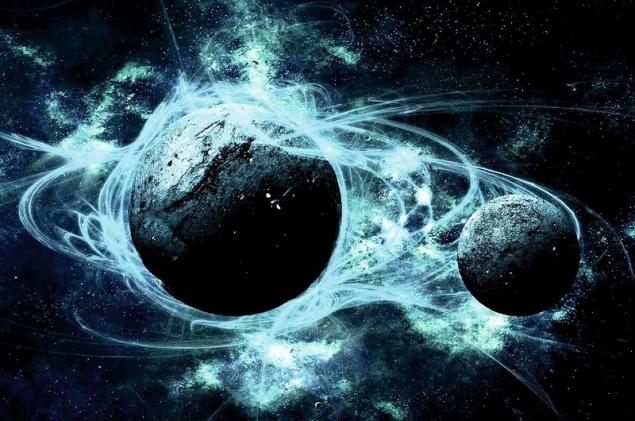
2. The effect of magnetic kinetron-electric induction. Built in 1831 by Michael Faraday, the effect is that when changing the magnetic flux penetrating the plane of the conductive frame, in the latter an electromotive force (EMF) cinetronic physical nature.
In Fig. 1 shows a conductive frame, the internal volume of which permeates the beam lines of force of the magnetic induction B(t) centered in a cylindrical volume. The lines of force of magnetic induction (when the density in the beam) are the initiators of the appearance of "electromotive" force (EMF), that is, the momentum of electrically charged particles in the electrically conductive material of the frame. This "electromotive force" (in Fig. 1 conventionally shown by the dotted arrows) is non-magnetic and non-electrical, micromechanical and physical nature/
It is shown that the ISS using the appropriate cinetronic vortex flows-waves (dotted circle in Fig. 1) passes the kinematic momentum and the energy of electrically charged particles. The appearance of asymmetry cinetronic flows, causing a gradient of "electromotive" force, is due to the "control signal" in the form of enhanced ISS cinetronic waves excited by due to the unsteady process of changing the number of lines of force in the beam. This effect allows you to create highly effective KST-EG PFC > 5 and an efficiency of > 85 %.
3. Hydro-cinetronic effect Yutkina. Opened in 1950. During electrical discharge in liquid is an electric explosion with the almost instant release of energy cinetronic flows in a volume around the electric discharge. The number and speed of the energy emitted in the electric discharge zone depends on many factors, including parameters of electrical discharge and fluid properties, and the compression wave that occurs when an intense evaporation of the liquid in the discharge zone and steam expansion in the electric arc gap can be called as single high-power pulsed electrical discharge between electrodes placed in liquid and a consistent series of impulses.
Extra energy this effect appears due to the sharp increase of the absorption coefficient cinetronic streams ISS, naturally penetrating the resonant volume of the liquid due to an electro-hydro-centralnogo impact excitation. This effect is the basis for developing a parametric series KST-EG that converts the energy of the ISS thermal and electric energy consumer format, wherein the working fluid is used, the gas-vapor mixture. The CMC of such systems may exceed five, but the efficiency of such converters rarely exceeds 80 %.
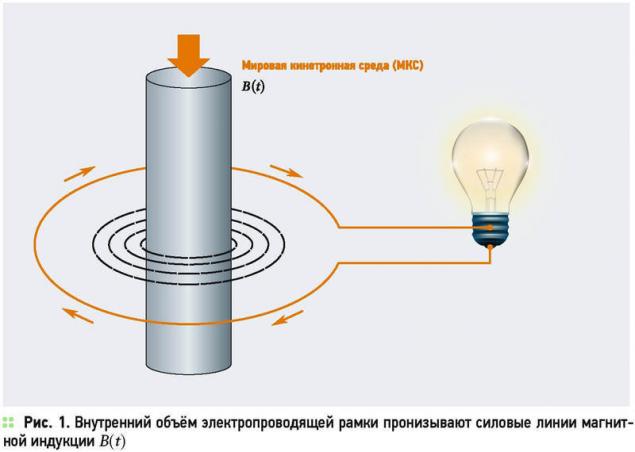
Additional energy in the Yutkin effect appears due to the sharp increase of the absorption coefficient cinetronic flows cinetronic world environment, naturally penetrating the resonant volume of the liquid due to an electro-hydro-centralnogo impact excitation
4. The reverse vortex effect dzhanibekova. In 1985 cosmonaut Vladimir Dzhanibekov, while on Board the orbital space station, discovered the phenomenon kinetron-vortex nature spun in zero gravity around its axis nut-"lamb" rotate evenly for a while, and then quickly spontaneously turned 180° and rotated further, then again spontaneously turned over, etc.
According to the law of conservation of angular momentum, the effect on the nut should act periodic external (reverse) Mineralnye flows of the ISS. When this occurs the mode of resonance absorption of the kinematic momentum and energy of these cinetronic flows.
This effect underlies the operation KST-EG: instead of nuts uses a permanent magnet placed inside an electric coil, the periodic change of the direction Magnitog flow penetrating a specified coil in accordance with the law of magnetic kinetron-electric induction, excites the coil EMF proportional to the rate of change of direction of the magnetic flux.
5. Kinetron-mechanical Casimir effect. The effect was discovered in 1948 and is "protalkivaya" (or repulsion) of two conductive bodies are electrically neutral due to the drop between such bodies pressure, ISS, due to the mutual screening of these bodies from the background cinetronic waves. The most pronounced effect for the two parallel mirror surfaces placed at a short distance. However, the Casimir effect exists for more complex topologies of telephone On the basis of the Casimir effect are implemented nanometric "cinetronic diodes", has unilateral conductivity cinetronic threads, which allows you to create KST-EG PFC of > 10 and with an efficiency of > 90 %.
6. Magnetic kinetron mechanical effect Minato. The effect was discovered in 1995. The essence of this effect concludes that the sawtooth is located on the non-magnetic disk, the permanent magnets provide self-sustaining rotation of the wheels in the presentation to the external magnetic clamps to the rim of the wheel. The magnets are positioned asymmetrically at the beginning of the disc rotation Minato from small external mechanical impulse cause in the initially isotropic volume of the ISS (in the gap between the rotor and the stator), the corresponding perturbation, and the resulting gradients of pressure ISS acting at a tangent to the rim of the rotor disc (similar to the "electromotive" kinetronics forces in the Faraday effect). Effect Minato used to create magneto-mechanical KST-converters with PFC > 5 and with an efficiency of > 80 %.
7. Magneto-cinetronic bistable effect of Floyd's Entourage. Opened in the early 1990's and manifested in the "bistable magnets" (BM) upon their excitation by pulses with a frequency coinciding with the resonance (magnetostrictive) frequency of BM. When an external magnetic field of small intensity due to the positive feedback in the structure BM is initiated avalanche process changes the magnetic polarity, this dramatically increases the absorption rate cinetronic streams (waves) of the ISS. The effect of Floyd's Entourage in SSC-EG allows to obtain the CMC is > 100 and an efficiency of > 90 %.
8. Kinetron-electric effect of the contact potential difference of Volt. Opened in the end of XVIII century: on the border of various substances (including metals) spontaneously arises the so-called "contact potential difference". The transition of free electrons from one substance to another is due to the influence of the contacting substances cinetronic flows of the ISS, as the topological structure of the electron shells of atoms such contact substances are very different: in case of contact of such substances to enter the resonant electro-Mineralnye the processes of local excitation of the ISS, leading to a sharp decrease of entropy in the contact zone of these substances. Therefore, the ISS in order to increase the entropy, directs quite organized (not chaotic) Mineralnye patki (waves) appears due to the specified resonance to repay the resonant low-entropic processes in the contact zone of these substances.
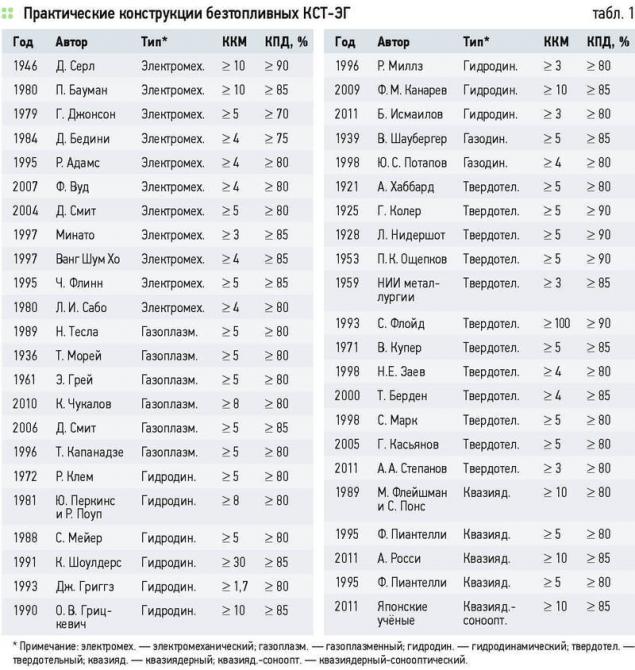
If you take one way or another converted free electrons from a substance-acceptor substance in the donor away from the contact in closed-circuit through the load electrical circuit using a special electro-centralnogo diode, such a system will constantly create a contact of EDS, effectively converting kinetron energy ISS energy coming then to the load. In 1950-ies of the academician P. K. Oshchepkov showed an experiment with a wire of an alloy of copper and aluminum in which the concentration of copper linearly decreases from one end of this wire to the other, and the concentration of aluminium is adequately increased. Cut this wire in the middle and inserting in that gap a light bulb, Oshchepkov showed "eternal" burning of a light bulb due to kinetron-electric effect of the contact potential difference.
9. The effect of burning salt water Kanzius. Opened in 2007. In the office of Kanzius working on the basis of this effect, the water is exposed to radio waves with a frequency of about 14 MHz, which weaken the bonds of the atoms in the water molecule due to resonance processes and release hydrogen. The additional energy for such a "super" resonance hydrolysis comes from the ISS. This allows you to create KST-EG with CMC > 2, and an efficiency of > 80 %.
The most rapidly implemented fuelless KST-EG in China. For example, the Chinese inventor Wang Noise Ho many times publicly demonstrated the work of his KST-EG (motor-generator), including at the Shanghai world EXPO 2010. In 2008, the KST-EG have successfully completed semi-annual testing, which was conducted in the framework of the energy programme of the Chinese government according to criteria of reliability and security. The government of China is considering a quick introduction of these KST-EG as a strategic direction for the booming Chinese SuperEnalotto. A few years ago, the Chinese government has allocated tens of billions of dollars to replace conventional generators on outdated coal-fired power plants on fuel-free KST-EG. Fuelless KST-EG it is planned to establish also on cars and other transport equipment.
Programs based on the same FTC scientific and technical approaches in superanalytic in full swing are being implemented in many countries. For example, in 2009 the U.S. Congress approved a package of emergency measures to improve the American economy a $ 787 billion, including on fuel-free super technologies. Similar to the KST program (primarily energy) are also implemented in Japan, Germany, Israel, India, Ireland, UAE, Hong Kong, Australia and many other countries. More than 50 firms in the world (including Boeing, GM, Mitsubishi, etc.) already began developing or even for serial production counterparts KST-EG. This is because a sufficiently high world energy prices lead to strong braking of the scientific-technological and social progress on the planet (stagnation in many sectors of the real economy), at the same time, in some countries, the extraction and sale of oil has a profit margin of over 800 % (UAE etc.).
The total drop of profitability from the sale of traditional types of energy makes the big monopolies in this sector to diversify their capital by investing significant funds (usually discreetly) in the development of supertechnology (analogous to FST) and especially in SuperEnalotto and supertransport

In addition, the General decline of profitability from the sale of traditional types of energy makes the big monopolies in this sector to diversify their capital by investing significant funds (usually discreetly) in the development of supertechnology (analogous to FST) and especially in SuperEnalotto and supertransport. published
Source: www.c-o-k.ru/articles/kinetronnye-supertehnologii-i-perspektivnaya-energetika
The concept of "cinetronic supertechnology" is a system combining the two approaches author: "cinetronic" and "supertechnology". In cinetronic proved rigorously that all the space the Universe is filled with minimal size and weight (and therefore indivisible, that is truly elementary, basic) particles of matter — "kinetonema (cinemas" — movement, "the throne" is the basic particle, base).
The scale of the Universe, the totality of moving CinemaNow forms a "world kinetron environment" (ISS), which in first approximation can be considered as a dense "Brownian cinetronic gas." ISS has tremendous energy density — more than 1033 j/m3 (estimates obtained through the application of classic models of etherodynamics), almost instantly renewable average energy density due to a huge speed (more 1021м/s — measured in 1987-1990), both CinemaNow and cinetronic waves in the ISS. This allows you to create effective Mineralnye Autonomous fuel-free power generators (EG) — thermal, electric, etc., while the only "fuel" for such are EG Mineralnye streams (waves) of the ISS.
In addition, under certain conditions, ISS may transfer kinematic momentum physical bodies (that is, to create a controlled thrust vector) that allows you to create effective Mineralnye drives, and fuel-free energy (and transport) system based on them that can function in any place of the world.
Basic principles cinetronic in good agreement with known (including classical) physical concepts ("atomistic" model of the world of Democritus, theory of the world Newton's laws of electromagnetism, etc.), and modern physical models (dark matter and Higgs bosons, string theory, etc.).
"Supertechnologies" approach provides an effective structurearticle methods for rapid development and implementation of a wide range of massively popular, environmentally safe, cheap and high quality goods and services (including in the fields of: Autonomous fuel-free clean energy and transport, processing and transfer of information, technological equipment for various purposes, construction, agriculture, Biomedicine, science, education, etc.), which are based on the extensive use of processes and effects cinetronic physical nature and possessing essentially new consumer properties.

In practical terms, the first fuel-free (in fact — kinetron) power generators (EG) was developed by Michael Faraday in 1831 (unfortunately, this KST-EGO was not entirely fuel-free); John Keely in 1872 (KST-EG using resonant vibration Mineralnye effects); Nathan Player in 1880 (KST-Aigues, using the effect of magnetic induction cinetronic); by Nikola Tesla in 1889 (KST-EG using a high-frequency high-voltage AcrobatReader and the resonant transformer of special design).
Nikola Tesla belongs to these truly prophetic words: "Our world is immersed in a huge ocean of energy, we are flying in an endless space with inconceivable speed. All around floats — all energy. Before us is a daunting task — to find ways to extract this energy. Then, removing her from an inexhaustible source, humanity will move forward with giant steps".
This is followed by the development of Alfred Hubbard (1921), Thomas Henry Moray (1926), Victor Schauberger (1920-1945), Hans Kohler (1920-1950), Wilhelm Reich (1940) and dozens of other inventors in the first half of the last century. Unfortunately, such designs are often not distinguished by high performance and had low stability. There were other disadvantages to such structures, not allowing it to quickly establish its serial production and marketing.
In just the past 125 years, the world has developed several dozens of different designs fuelless KST-EG (and KST-engines), some of them produced in small batches under specific orders. The unit cost of these CST-systems remains high — more than $ 1,000 per 1 kW, however, with the improvement of KST designs of such systems, supertechnology their manufacture and because of the increase in the serial production, the unit cost is falling rapidly and within a few years could decline below $ 200 per 1 kW.
The conversion of energy ISS
The main task of any fuelless KST-EG (that is, the Converter of energy ISS energy consumer format) is the conversion of three-dimensional (3D) format centralnogo Brownian gas of the ISS in the local working volume in one-dimensional (1D) cinetronic stream, which in the second stage is converted into a unidirectional material flow consumer format: W-the flow of the heated coolant, electric-current, high-speed flow of liquid, gas or solid, etc.
It should be noted that the potential power density of the world cinetronic environment may be more than 1052 W/m3, while the power density and energy density of the magnetic, electric, electromagnetic and gravitational fields is disproportionately less power density and energy density cinetronic world environment. Real-KST-EG use only a tiny part of the potential specific power of the ISS — at least 10-40, while the specific power output of this EG may be more than 10 MW/m3 (or 10 kW/l), which is sufficient for practical purposes.

Consider two clear examples of conversion of energy ISS:
Example 1. It is known that a permanent magnet can perform work (mechanical, generate electricity, etc.) for thousands of years without losing its magnetic properties; however, it is obvious that the magnet, doing this kind of work, expends its energy. At the same time, if making the work of the magnet to surround the magnetic screen, then very quickly the magnet will lose its magnetic properties and ceases to perform work. This suggests that the magnet receives reimbursement of its cost of energy from the ISS along the magnetic field lines, which are in fact very thin mineralnymi closed vortices and function as effective "centronova" collecting kinetron energy from the large volume and concentrating it within the body of the magnet.
Example 2. Modern refrigerator, consuming from the power supply 1 kW of power moves from the internal volume to the outside heat power of about 5 kW, that is five times more than it consumes from the mains. If the output thermal power to convert into electricity, it is possible to implement "samosejka" of the refrigerator, turning it thereby into an Autonomous fuel-free KST-EG. Obviously, this is only possible due to the fact that the evaporation and condensation of refrigerant-refrigerator receives energy supply from the ISS: of 5 kW of output heat output 4 kW is the contribution cinetronic energy ISS.
Energy efficiency KST-EG is estimated following two basic parameters:
1. Coefficient of performance (COP) — the ratio of power output to the load (useful output) to total power of all energy flows within the active workspace EG (total power consumption). Efficiency is always less than 1 or 100% as part of consumption (from all energy sources) of power is lost in the EGO in the process of converting it into useful power.
2. Conversion rate power (PFC) — the ratio of power output to the load (useful power) to the power expended to run the EG in the operating mode and its support. Registers in effective KST-EG always significantly greater than 1 (or 100 %) as a smaller part of the power consumption of the ISS is used to start and support the working mode and substantially most of this absorbed power is converted to consumer format, and is transmitted payload. It is therefore often KST-EG is conventionally called "super" or "fuel-less".

The underlying physical effects used in KST-EG
It should be noted that to date, there are dozens of different physical effects cinetronic nature, used to work KST-EG, and the number of such effects is growing every year. We restrict ourselves to only basic cinetronic physical effects, which are most often used in KST-EG.
All the basic Mineralnye physical effects almost solve similar problems in superanalytic: ensure transformation of the energy cinetronic SD streams Brownian (chaotic) of the ISS in the ID and energy (organized) streams in consumer format: heat flow, electric current, mechanical motion.
Over the past 125 years, the world has developed several dozens of different designs fuelless KST-Aigues, some of them produced in small batches. The unit cost of these CST-systems while more than $ 1,000 per 1 kW, however, with the improvement of designs and manufacturing techniques and because of the increase in the serial production, the unit cost in a few years could decline below $ 200 per 1 kW
1. Kinetron-mechanical "gravity effect". Usually under gravity understand "the attraction of one physical body (object) to others." However, from the first Newton's law, it follows that no two physical bodies at a distance greater than the dimensions of these bodies can impact directly on each other, that is, to pass each other, the kinematic momentum, energy, and information, as in the absence of contact interaction between two bodies each of the bodies moves uniformly (unless the body contact will not interact with other physical bodies). Whence it follows that for indirect physical effects at a distance of one body on another, must be other bodies or particles-mediators (usually very small) that implement the relay transmission and the kinematic momentum.
Thus, from Newton's first law of strictly logical need for the existence of the ISS, filling the entire space of the Universe, and it follows that the gravitational interaction of bodies is impossible without the availability of the ISS (a nonzero value of the gravitational constant clearly indicates the presence of a global material environment).
In this case, the physical mechanism is actually one body attracts another body at a distance, and only creates Centralnoe screening "kinetron wave shadow" that reduces pressure of the ISS between bodies, compared to centralnym pressure of the ISS on the external side of the bodies. the Gradient of this pressure and cause the "protalkivaya" of such bodies to each other with a force proportional to the mass of the objects and inversely proportional to the square of the distance between them. In other words, these bodies do not "gravitate", and "protalkivaya" to each other, ISS. The management of such a process of "protalkivaya" bodies due to the energy and kinematical momentum of the ISS allows to create an effective KST-EG PFC > 5 and an efficiency of > 85 %.

2. The effect of magnetic kinetron-electric induction. Built in 1831 by Michael Faraday, the effect is that when changing the magnetic flux penetrating the plane of the conductive frame, in the latter an electromotive force (EMF) cinetronic physical nature.
In Fig. 1 shows a conductive frame, the internal volume of which permeates the beam lines of force of the magnetic induction B(t) centered in a cylindrical volume. The lines of force of magnetic induction (when the density in the beam) are the initiators of the appearance of "electromotive" force (EMF), that is, the momentum of electrically charged particles in the electrically conductive material of the frame. This "electromotive force" (in Fig. 1 conventionally shown by the dotted arrows) is non-magnetic and non-electrical, micromechanical and physical nature/
It is shown that the ISS using the appropriate cinetronic vortex flows-waves (dotted circle in Fig. 1) passes the kinematic momentum and the energy of electrically charged particles. The appearance of asymmetry cinetronic flows, causing a gradient of "electromotive" force, is due to the "control signal" in the form of enhanced ISS cinetronic waves excited by due to the unsteady process of changing the number of lines of force in the beam. This effect allows you to create highly effective KST-EG PFC > 5 and an efficiency of > 85 %.
3. Hydro-cinetronic effect Yutkina. Opened in 1950. During electrical discharge in liquid is an electric explosion with the almost instant release of energy cinetronic flows in a volume around the electric discharge. The number and speed of the energy emitted in the electric discharge zone depends on many factors, including parameters of electrical discharge and fluid properties, and the compression wave that occurs when an intense evaporation of the liquid in the discharge zone and steam expansion in the electric arc gap can be called as single high-power pulsed electrical discharge between electrodes placed in liquid and a consistent series of impulses.
Extra energy this effect appears due to the sharp increase of the absorption coefficient cinetronic streams ISS, naturally penetrating the resonant volume of the liquid due to an electro-hydro-centralnogo impact excitation. This effect is the basis for developing a parametric series KST-EG that converts the energy of the ISS thermal and electric energy consumer format, wherein the working fluid is used, the gas-vapor mixture. The CMC of such systems may exceed five, but the efficiency of such converters rarely exceeds 80 %.

Additional energy in the Yutkin effect appears due to the sharp increase of the absorption coefficient cinetronic flows cinetronic world environment, naturally penetrating the resonant volume of the liquid due to an electro-hydro-centralnogo impact excitation
4. The reverse vortex effect dzhanibekova. In 1985 cosmonaut Vladimir Dzhanibekov, while on Board the orbital space station, discovered the phenomenon kinetron-vortex nature spun in zero gravity around its axis nut-"lamb" rotate evenly for a while, and then quickly spontaneously turned 180° and rotated further, then again spontaneously turned over, etc.
According to the law of conservation of angular momentum, the effect on the nut should act periodic external (reverse) Mineralnye flows of the ISS. When this occurs the mode of resonance absorption of the kinematic momentum and energy of these cinetronic flows.
This effect underlies the operation KST-EG: instead of nuts uses a permanent magnet placed inside an electric coil, the periodic change of the direction Magnitog flow penetrating a specified coil in accordance with the law of magnetic kinetron-electric induction, excites the coil EMF proportional to the rate of change of direction of the magnetic flux.
5. Kinetron-mechanical Casimir effect. The effect was discovered in 1948 and is "protalkivaya" (or repulsion) of two conductive bodies are electrically neutral due to the drop between such bodies pressure, ISS, due to the mutual screening of these bodies from the background cinetronic waves. The most pronounced effect for the two parallel mirror surfaces placed at a short distance. However, the Casimir effect exists for more complex topologies of telephone On the basis of the Casimir effect are implemented nanometric "cinetronic diodes", has unilateral conductivity cinetronic threads, which allows you to create KST-EG PFC of > 10 and with an efficiency of > 90 %.
6. Magnetic kinetron mechanical effect Minato. The effect was discovered in 1995. The essence of this effect concludes that the sawtooth is located on the non-magnetic disk, the permanent magnets provide self-sustaining rotation of the wheels in the presentation to the external magnetic clamps to the rim of the wheel. The magnets are positioned asymmetrically at the beginning of the disc rotation Minato from small external mechanical impulse cause in the initially isotropic volume of the ISS (in the gap between the rotor and the stator), the corresponding perturbation, and the resulting gradients of pressure ISS acting at a tangent to the rim of the rotor disc (similar to the "electromotive" kinetronics forces in the Faraday effect). Effect Minato used to create magneto-mechanical KST-converters with PFC > 5 and with an efficiency of > 80 %.
7. Magneto-cinetronic bistable effect of Floyd's Entourage. Opened in the early 1990's and manifested in the "bistable magnets" (BM) upon their excitation by pulses with a frequency coinciding with the resonance (magnetostrictive) frequency of BM. When an external magnetic field of small intensity due to the positive feedback in the structure BM is initiated avalanche process changes the magnetic polarity, this dramatically increases the absorption rate cinetronic streams (waves) of the ISS. The effect of Floyd's Entourage in SSC-EG allows to obtain the CMC is > 100 and an efficiency of > 90 %.
8. Kinetron-electric effect of the contact potential difference of Volt. Opened in the end of XVIII century: on the border of various substances (including metals) spontaneously arises the so-called "contact potential difference". The transition of free electrons from one substance to another is due to the influence of the contacting substances cinetronic flows of the ISS, as the topological structure of the electron shells of atoms such contact substances are very different: in case of contact of such substances to enter the resonant electro-Mineralnye the processes of local excitation of the ISS, leading to a sharp decrease of entropy in the contact zone of these substances. Therefore, the ISS in order to increase the entropy, directs quite organized (not chaotic) Mineralnye patki (waves) appears due to the specified resonance to repay the resonant low-entropic processes in the contact zone of these substances.

If you take one way or another converted free electrons from a substance-acceptor substance in the donor away from the contact in closed-circuit through the load electrical circuit using a special electro-centralnogo diode, such a system will constantly create a contact of EDS, effectively converting kinetron energy ISS energy coming then to the load. In 1950-ies of the academician P. K. Oshchepkov showed an experiment with a wire of an alloy of copper and aluminum in which the concentration of copper linearly decreases from one end of this wire to the other, and the concentration of aluminium is adequately increased. Cut this wire in the middle and inserting in that gap a light bulb, Oshchepkov showed "eternal" burning of a light bulb due to kinetron-electric effect of the contact potential difference.
9. The effect of burning salt water Kanzius. Opened in 2007. In the office of Kanzius working on the basis of this effect, the water is exposed to radio waves with a frequency of about 14 MHz, which weaken the bonds of the atoms in the water molecule due to resonance processes and release hydrogen. The additional energy for such a "super" resonance hydrolysis comes from the ISS. This allows you to create KST-EG with CMC > 2, and an efficiency of > 80 %.
The most rapidly implemented fuelless KST-EG in China. For example, the Chinese inventor Wang Noise Ho many times publicly demonstrated the work of his KST-EG (motor-generator), including at the Shanghai world EXPO 2010. In 2008, the KST-EG have successfully completed semi-annual testing, which was conducted in the framework of the energy programme of the Chinese government according to criteria of reliability and security. The government of China is considering a quick introduction of these KST-EG as a strategic direction for the booming Chinese SuperEnalotto. A few years ago, the Chinese government has allocated tens of billions of dollars to replace conventional generators on outdated coal-fired power plants on fuel-free KST-EG. Fuelless KST-EG it is planned to establish also on cars and other transport equipment.
Programs based on the same FTC scientific and technical approaches in superanalytic in full swing are being implemented in many countries. For example, in 2009 the U.S. Congress approved a package of emergency measures to improve the American economy a $ 787 billion, including on fuel-free super technologies. Similar to the KST program (primarily energy) are also implemented in Japan, Germany, Israel, India, Ireland, UAE, Hong Kong, Australia and many other countries. More than 50 firms in the world (including Boeing, GM, Mitsubishi, etc.) already began developing or even for serial production counterparts KST-EG. This is because a sufficiently high world energy prices lead to strong braking of the scientific-technological and social progress on the planet (stagnation in many sectors of the real economy), at the same time, in some countries, the extraction and sale of oil has a profit margin of over 800 % (UAE etc.).
The total drop of profitability from the sale of traditional types of energy makes the big monopolies in this sector to diversify their capital by investing significant funds (usually discreetly) in the development of supertechnology (analogous to FST) and especially in SuperEnalotto and supertransport

In addition, the General decline of profitability from the sale of traditional types of energy makes the big monopolies in this sector to diversify their capital by investing significant funds (usually discreetly) in the development of supertechnology (analogous to FST) and especially in SuperEnalotto and supertransport. published
Source: www.c-o-k.ru/articles/kinetronnye-supertehnologii-i-perspektivnaya-energetika





